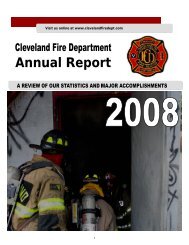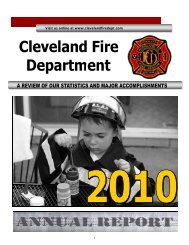SOP Manual - Cleveland Fire Department
SOP Manual - Cleveland Fire Department
SOP Manual - Cleveland Fire Department
- No tags were found...
You also want an ePaper? Increase the reach of your titles
YUMPU automatically turns print PDFs into web optimized ePapers that Google loves.
<strong>Cleveland</strong> <strong>Fire</strong> <strong>Department</strong><br />
Operations <strong>Manual</strong><br />
When you cut a hole in a roof cut a big one.<br />
We ventilate to alter the interior conditions. The best operating position to determine if a building requires<br />
ventilation and the locations and timing of ventilation is the inside attack team. Interior and roof forces<br />
must communicate in order to coordinate the effort effectively.<br />
Do not operate hand lines, particularly ladder pipes, down ventilation holes. Operate hose lines on roofs<br />
only for the protection of personnel and external exposures.<br />
Effective topside ventilation will tend to keep roofs intact longer and roof condition necessarily becomes<br />
extremely important to ventilation activities. If ladder crews cannot get on the roof to ventilate because of<br />
advanced fire, Command had best begin to REACT in marginal offensive/defensive terms. Hose line crews<br />
can probably get inside and stay inside longer than ladder crews can stay on the roof. AXIOM: It is better<br />
to abandon the building a bit soon rather than a bit too late.<br />
Forcible entry involves a trade-off in time versus damage; the faster you force -- the more damage you do.<br />
The more critical the fire, the less important forcible entry damage becomes and vise versa. If the fire is<br />
progressing and you must go in and attack from the unburned side, don’t waste time trying to pick the locks<br />
-- force the door open.<br />
REMEMBER -- Try before you pry!<br />
The provision of access many times will determine if the fire is cut off and extinguished or not. These<br />
access-oriented activities generally involve pulling ceilings, opening up concealed spaces and voids, and<br />
the activities required to get fire attack efforts in to operate on hidden fire. Such operations beat up the fire<br />
building and must be done in a timely well placed manner. In such cases, do not hesitate -- if you size up<br />
fire working inside a concealed space, get ahead of it, open up and cut it off.<br />
Beware of the premature opening of doors, holes, access efforts, etc. before lines are in place and crews are<br />
ready to go inside. Good timing requires effective communication between Engine Companies or attack<br />
teams, Ladder Companies and Command.<br />
When laddering a roof, the ladder selected shall be one, which will extend 2' -- 3' above the roofline. This<br />
shall be done in an effort to provide personnel operating on the roof with visible means of egress.<br />
Once a building is laddered, NO PERSONNEL SHALL REMOVE THE LADDER FROM THE<br />
BUILDING DURING FIREFIGHTING OPERATIONS EXCEPT FOR THE CREW WHO<br />
PLACED THE LADDER IN SERVICE. If a ladder has to be moved, personnel shall climb the ladder<br />
and check for personnel operating above the fire (i.e. roof, second floor, etc.) before moving the ladder.<br />
If possible, when laddering buildings under fire conditions, place ladders near building corners or fire walls<br />
as these areas are generally more stable in the event of structural failure.<br />
When using the aerial ladder or Snorkel, the apparatus should be spotted at or near the corner of the<br />
structure. This gives the aerial apparatus the ability to reach two separate sides of the building. Also, the<br />
corner of the building is more stable in cases of structural failure.<br />
Mechanical ventilation of a building requires a coordinated effort between Engine Companies and Ladder<br />
Companies. Remember that mechanical ventilation forces in or out large volumes of air and may increase<br />
the rate in which the fire is spreading.<br />
Effective: June 1, 1997 Revised: 5/14/2009 Page | 194<br />
Approved by: Chief Chuck Atchley




